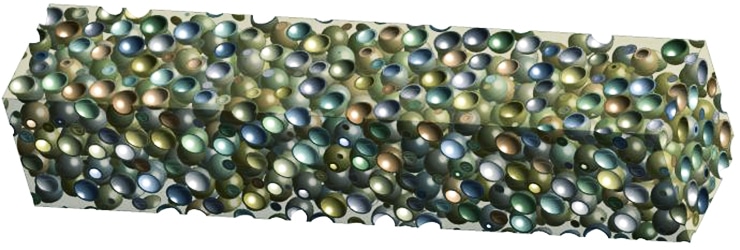Researchers have developed a way to make cheaper, lighter-weight syntactic foams at industrial scale, paving the way for more efficient, less costly products and vehicles.
Syntactic foams—strong, exceptionally light materials made of plastic perfused with hollow microspheres—are used in everything from buoys and boat hulls to soccer balls and solid rocket boosters. Because they weigh less than molded plastic components, they are now making their way into new industries, including the automotive sector and consumer products.

Producing syntactic foams at industrial scale is a challenge, however, because the microspheres tend to break during the mixing process, which increases the density of the final product, thereby reducing its key advantage.
“Sophisticated, light-weight materials, such as syntactic foams, are key to making today’s cars and trucks more efficient…”
This is why, while there are dozens of manufacturers of plastic precursors, such as polyethylene, polystyrene, and vinyl, and several of microspheres, few companies can make syntactic foam, especially of molded thermoplastics, at industrial volumes.
Now, researchers studying the means by which smaller plastic components manufacturers can create these strong, light compounds by mixing hollow microspheres into molded plastic products have proved that the materials can be produced with economies of scale by smaller companies for automotive and consumer products sectors.
In research published in the journal Composites Part B, the team developed a compression-molding-based processing method for syntactic foam comprising of glass microballoons or fly ash cenospheres permeating high-density polyethylene.
Achieving a 36 percent weight reduction in these plastics while conferring better mechanical properties, the researchers were able to make components lighter and cheaper, while reducing their manufacturing carbon footprints.
“At laboratory scale, when you are mixing components in a flask, you can be careful and minimize damage,” says Nikhil Gupta, an associate professor of mechanical and aerospace engineering at New York University. “But at an industrial scale, producers have to make large quantities of material quickly, because time is money. Thus, breakage of these particles becomes much more problematic.”
To minimize microsphere fractures, the team developed parameters for use by small operations with industrial injection molding machines. After Gupta performed the mathematical modeling necessary to find optimal mix ratios, the researchers turned to India’s abundance of small-scale manufacturers who employ plastic molding equipment to test the concepts. The team then collaborated with the manufacturers to fine-tune mixing parameters.
Stronger, lighter steel could soon end up in cars
“Sophisticated, light-weight materials, such as syntactic foams, are key to making today’s cars and trucks more efficient, regardless of whether they run on gasoline or electricity,” says Katepalli R. Sreenivasan, dean of the Tandon School of Engineering at New York University.
“Because these light-weight components confer cost and energy benefits while lowering the carbon footprint of suppliers, automakers, and consumers alike, this research could lead to windfalls not just for industry, but for society as a whole.”
Gothic cathedrals inspire very thin concrete floors
With the help of industry, the research team now plans to extend the work to cast prototype components and to test them in actual applications.
Researchers at the National Institute of Technology-Karnataka in India are collaborators on the research.
Source: New York University



